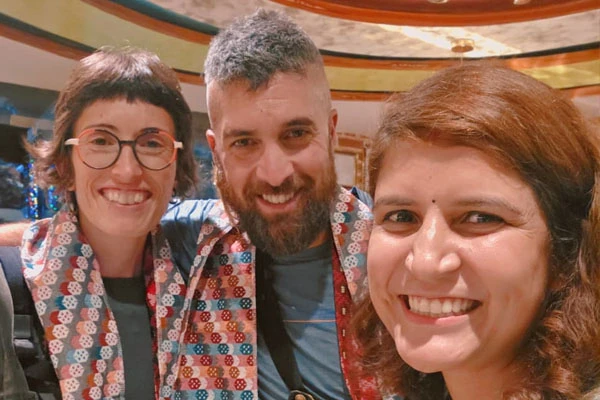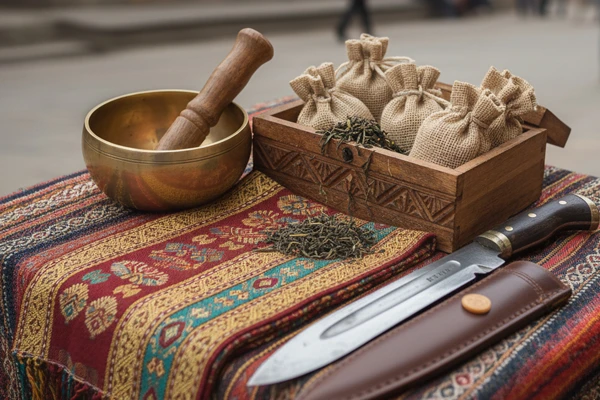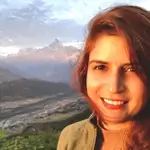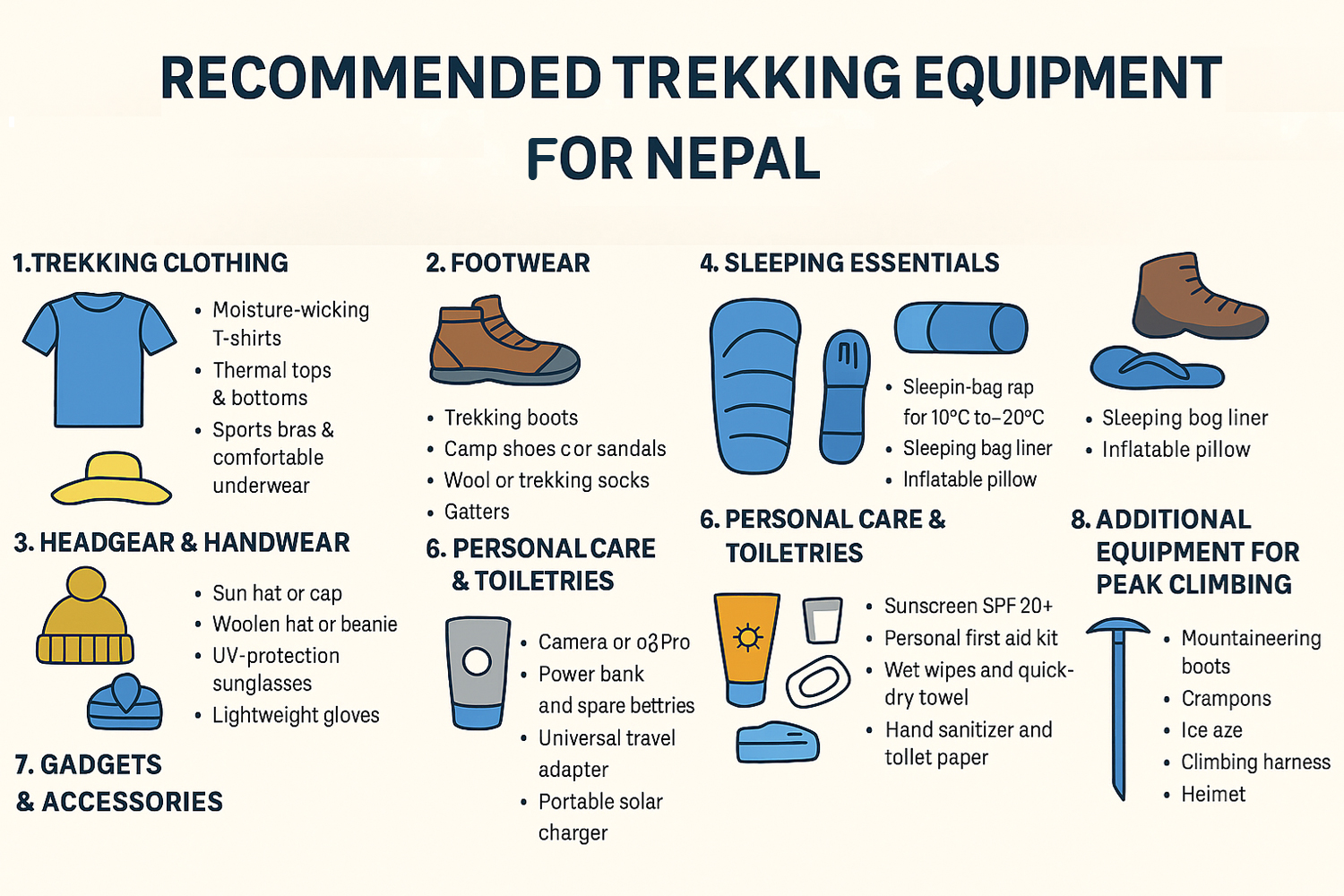
Recommended Trekking Equipment for Nepal: What to Pack for Trek

Table of Contents
Introduction: Recommended Trekking Equipment for Nepal
Planning a trek in Nepal is an unforgettable experience — from the towering peaks of the Everest region to the serene trails of Annapurna and Langtang. But to make the most of your adventure, the right trekking equipment is essential. Whether you are hiking to Everest Base Camp, conquering Annapurna Circuit, or exploring short treks near Kathmandu, being properly equipped can make the difference between a comfortable and challenging journey.
In this guide, we share a comprehensive list of recommended trekking gear for Nepal, along with expert tips to help you pack smart and stay safe in the Himalayas.
Why Proper Trekking Gear Matters
Nepal’s trekking trails cross diverse landscapes — from subtropical forests and alpine meadows to snowy high passes above 5,000 meters. Weather conditions can change quickly, so the right clothing, shoes, and gear are crucial for:
🥾 Staying warm and dry in unpredictable weather
🎽 Preventing altitude-related fatigue with lightweight, breathable clothing
🛡️ Ensuring safety and comfort during long treks
🌄 Making your trekking experience enjoyable and stress-free
Complete Equipment Checklist for Trekking in Nepal
Trekking Clothing
Layering is the golden rule. Pack clothing that can be adjusted according to changing temperatures.
- Moisture-wicking T-shirts (2–3)
- Thermal tops & bottoms (for colder treks)
- Sports bras & comfortable underwear
- Fleece jackets or pullovers
- Lightweight down or synthetic jacket
- Waterproof and windproof jacket with hood
- Waterproof trekking pants or windbreaker pants
- Quick-dry trekking pants (2 pairs)
- Convertible trekking shorts (optional)
- Sun-protective long-sleeve shirt
- Warm woolen sweater (for evenings)
Footwear
Your feet are your best friends on the trail. Choose quality shoes that provide comfort and grip.
- Trekking boots: Waterproof, ankle-supportive, and well-broken-in.
- Camp shoes or sandals: For relaxing in teahouses or campsites.
- Socks: 2–3 pairs of thick wool socks + 2 pairs of lightweight trekking socks.
- Gaiters: Essential for snow and muddy trails during winter and monsoon.
Headgear & Handwear
- Sun hat or cap
- Woolen hat or beanie for cold mornings
- UV-protection sunglasses
- Lightweight gloves for mild weather
- Insulated gloves for high-altitude treks
Sleeping Essentials
- Sleeping bag rated for −10°C to −20°C (depending on altitude and season)
- Sleeping bag liner (optional but useful)
- Inflatable pillow (optional)
Trekking Gear
- Trekking poles for stability on steep trails.
- Water bottles or hydration bladder (at least 2 liters).
- Sunglasses with UV protection.
- Rain cover for backpacks.
- Headlamp with spare batteries.
Personal Care & Toiletries
- Sunscreen SPF 30+ and lip balm with UV protection.
- Personal first aid kit (plasters, painkillers, Diamox, antiseptic cream).
- Wet wipes and quick-dry towel.
- Hand sanitizer and toilet paper.
- Toothbrush, toothpaste, and soap.
- Comb
- Small mirror (optional).
Gadgets & Accessories
- Camera or GoPro for capturing memories.
- Power bank and spare batteries.
- Universal travel adapter.
- Portable solar charger (optional but useful on long treks).
- Lightweight book or Kindle for evening relaxation.
Comfortable Backpack & Duffel Bag
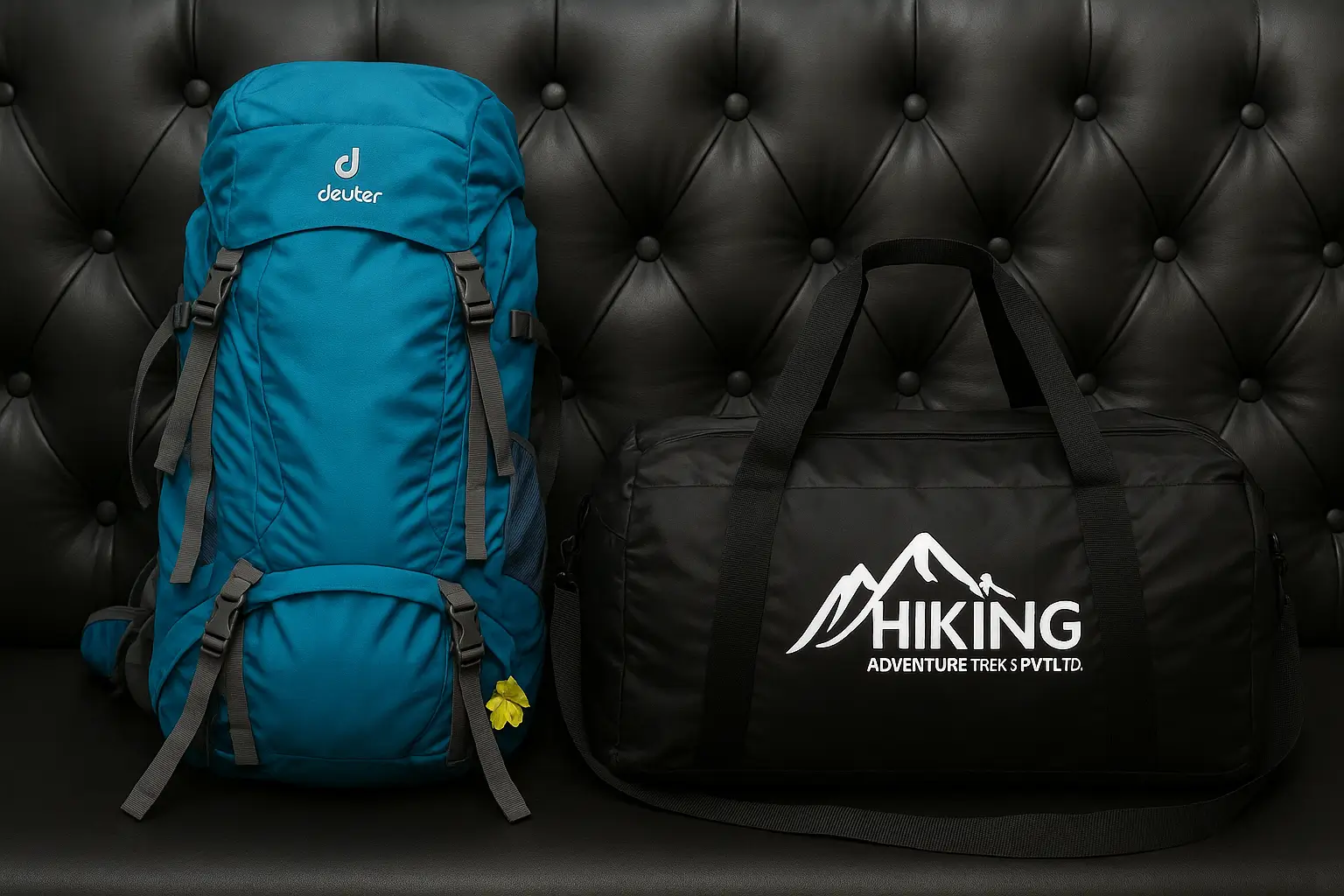
One of the most overlooked essentials for trekking in Nepal is choosing the right backpack:
- Daypack (30–40L): For carrying your daily essentials — water, snacks, camera, sunscreen, rain jacket, and personal items. Make sure it has padded straps and a waist belt for maximum comfort.
- Duffel Bag (60–80L): At Hiking Adventure Treks, we provide duffel bags for clients and arrange professional porters to carry them. You’ll only need to manage your daypack, making your trek lighter and more enjoyable.
- Rain Cover: Always protect your gear from unexpected showers.
First Aid Kit & Emergency Essentials 🩺
Trekking in Nepal often involves remote areas where medical facilities may not be readily available. Carrying a personal first aid kit ensures that you are prepared for minor injuries, altitude-related issues, and other emergencies.
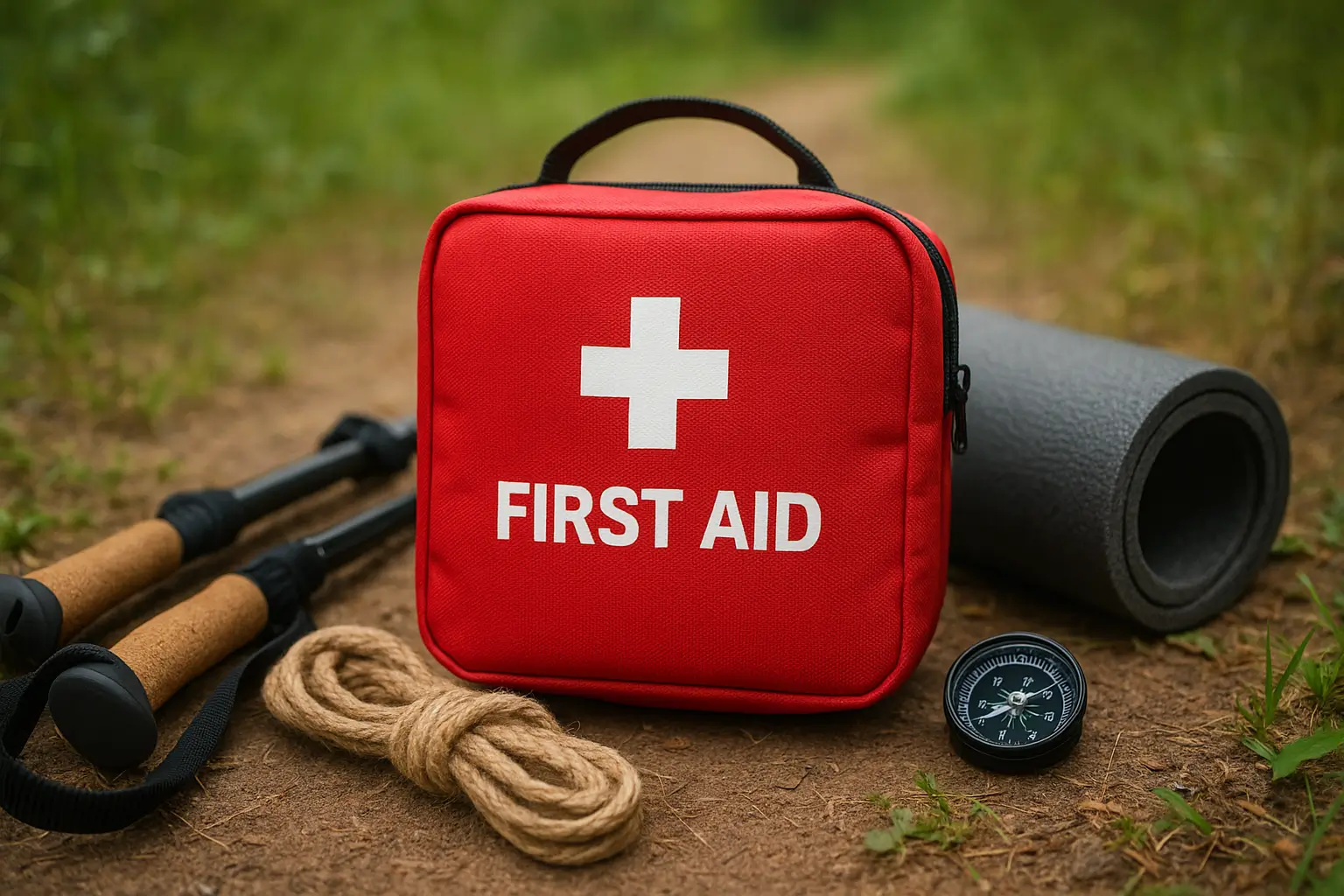
Basic First Aid Items
- Adhesive bandages & blister plasters – 🩹
- Antiseptic wipes or iodine solution – 🧴
- Painkillers (Paracetamol, Ibuprofen) – 💊
- Anti-diarrheal tablets – 🩺 (or 💊)
- Antihistamines for allergies – 🤧
- Motion sickness tablets – 🤢
- Small scissors, tweezers & safety pins – ✂️
Altitude Sickness Medication
- Diamox (Acetazolamide): Helps prevent and manage AMS (consult your doctor before use)
- Portable pulse oximeter (optional but useful to monitor oxygen levels)
Personal Medications
- Any prescription medicines you take regularly
- Spare doses stored separately in case of loss
Emergency Items
- Water purification tablets / filter bottle – 💧
- Electrolyte powders – 🥤
- Whistle & small mirror – 📯 / 🪞
- Travel insurance & emergency contacts – 📄 / 📞
At Hiking Adventure Treks, our guides always carry a comprehensive medical kit during our treks, but we still recommend trekkers bring personal medications for comfort and safety.
Seasonal Equipment Recommendations
| Season | Temperature | Recommended Additions |
| Spring (Mar-May) | Mild, 5°C to 20°C | Light fleece, breathable shirts, sun protection gear. |
| Monsoon (Jun–Sep) | Warm & rainy | Waterproof boots, rain poncho, quick-dry clothing, insect repellent. |
| Autumn (Oct–Nov) | Cool & dry | Perfect weather — standard packing list works best. |
| Winter (Dec–Feb) | Freezing at night | Extra down jacket, thermal underwear, heavier sleeping bag, insulated gloves. |
Pro Tips from Local Guides
✅Rent or Buy in Kathmandu: Thamel has plenty of gear shops offering quality equipment for rent or purchase at great prices.
✅Pack Light, Pack Smart: The lighter your backpack, the more enjoyable your trek.
✅Break In Your Boots: Wear your trekking boots before the trip to avoid blisters.
✅Stay Hydrated: Carry water purification tablets or a filter bottle.
✅Respect Local Culture: Dress modestly in villages.
Additional Equipment for Peak Climbing
If your trekking plan includes climbing trekking peaks like Island Peak, Mera Peak, Lobuche East, or similar, you’ll need specialized climbing gear in addition to the standard trekking equipment.
- Mountaineering boots (double insulated recommended for 6,000m+ peaks)
- Crampons (compatible with your boots)
- Ice axe
- Climbing harness
- Carabiners (locking and non-locking)
- Ascenders and descenders (Jumar or similar devices)
- Helmet (lightweight but sturdy)
- Safety ropes (usually provided by your guide, but confirm in advance)
- Clothing Upgrades for Climbing
- High-altitude down jacket (rated for −20°C or colder)
- Expedition-grade gloves and liners
- Balaclava or high-altitude face mask
- Glacier sunglasses or goggles
- Sleeping & Camping Essentials
- Four-season sleeping bag
- Inflatable mattress or foam pad for high camps
- Personal tent (if not provided by the expedition team)
Pro Tip: Most climbing-specific equipment can be rented in Kathmandu at affordable rates, especially around Thamel. For climbs in the Everest region, gear is also available locally — at Dingboche for Island Peak, Lobuche for Lobuche Peak, and Khare for Mera Peak.
Buying and Renting Gears in Nepal
Nepal is also the best for trekkers who don’t want to carry all their equipment from home. Most of the city areas offers excellent options for both buying and renting trekking gear. Thamel (Kathmandu) and Lakeside (Pokhara) are packed with shops selling everything from budget-friendly local brands to high-end international gear at competitive prices. You can find quality jackets, boots, backpacks, and accessories, often at lower costs than in Western countries. Many stores also offer rental services for bulky or expensive items like down jackets, sleeping bags, and trekking poles. This is ideal for those looking to save money and luggage space.
Renting is particularly convenient for one-time trekkers, while buying may be better for frequent adventurers. Just be sure to inspect rented gear for quality and functionality before your trek. Whether you purchase or rent, Nepal’s trekking hubs make it easy to get fully equipped without the hassle of carrying everything from home.
Popular City to Rent Trekking Gear in Nepal
Kathmandu is the most popular city in Nepal for renting trekking gear, offering countless shops with high-quality equipment at affordable prices. The Thamel, Pokhara or Namche is a trekker's hub. These places are packed with rental stores selling or leasing everything from down jackets and sleeping bags to trekking poles and crampons. Many shops provide well-maintained, branded gear at reasonable daily rates, making it ideal for travelers who want to avoid carrying bulky equipment.
Popular rental outlets offer reliable options, often with flexible rental periods. Renting in Kathmandu is convenient, cost-effective, and allows you to access last-minute gear without the hassle of bringing everything from home. Additionally, most rental shops provide brief inspections and cleaning services, ensuring the equipment is in good condition before your trek. Whether you need high-altitude gear for Everest or basic essentials for the Annapurna Circuit, Kathmandu has you covered.
Recommended Shops to Buy Trekking & Climbing Gear in Thamel
Thamel, Kathmandu’s vibrant tourist hub, is a paradise for trekkers and climbers. Whether you’re preparing for the Everest Base Camp trek, an Annapurna adventure, or a peak climbing expedition, Thamel has everything you need — from high-quality branded gear to affordable alternatives.
Here are some of the best shops in Thamel for your trekking and climbing needs:
👍Alpine Equipments Hub Thamel (Premium Quality) 🏔️
If you want original, high-quality gear, this is one of the best places to shop in Thamel. They specialize in professional climbing and trekking equipment, carrying brands like La Sportiva shoes, Black Diamond gear, and other premium international products.
Best For: Professional climbers and trekkers
Price Range: Higher
Tip: Ideal if you want durable gear for peak climbing and expeditions.
👍Kalapattar Shop (Trusted & Popular) 🎒
Kalapattar is a household name among trekkers in Nepal. Almost every experienced trekker in Kathmandu knows this shop. They provide good quality trekking gear at reasonable prices, including down jackets, sleeping bags, boots, and more.
Best For: Trekking essentials at mid-range prices
Price Range: Medium
Tip: Perfect if you want reliable gear without going premium.
👍Wild Everest Trekking Shop (Variety Under One Roof) 🧢
If you’re looking for a one-stop shop with lots of options, Wild Everest is your place. From colorful trekking jackets to camping essentials, you’ll find everything under one roof.
Best For: Trekkers who love variety and color options
Price Range: Medium to high
Tip: Great for last-minute shopping before your trek.
💡 Pro Tip:
If you’re on a tight budget, Thamel also has replica gear shops where you can get cheaper alternatives. But for climbing expeditions, always invest in original, high-quality equipment for safety and comfort.
Ultimate Trekking Checklist for Nepal ✅
Clothing & Footwear 👕🥾 ✅ T-shirts (full & half sleeve) ✅ Fleece jacket ✅ Wind cheater / waterproof jacket ✅ Thick jacket (down recommended for 4000–5000m+) ✅ Hiking / trekking pants ✅ Trekking boots (waterproof, lightweight, well-broken-in) ✅ Sandals or comfortable non-slippery slippers (can be worn with socks) ✅ Warm cap / beanie ✅ Scarf or buff (protects cheeks from cold and wind) ✅ Gloves (lightweight + insulated for high altitudes) ✅ Raincoat / poncho | Gear & Accessories 🎒🧭 ✅Day Pack (30-40L) ✅Duffel bag (60–80L) for porter or storing extra gear) ✅ Hiking poles (great for support on long treks) ✅ Torch / headlamp (with spare batteries) ✅ Water bottle + water purification tablets ✅ Thermos (optional, for hot drinks in cold weather) ✅ Power bank or solar charger ✅ Sunglasses with UV protection ✅ Sunscreen & lotion ✅ Lip balm with SPF |
Sleeping & Camping 🛏️⛺ ✅ Sleeping bag (suitable for −10°C to −20°C depending on season) ✅ Inflatable pillow or small camping pillow (optional) ✅ Sleeping mat / foam pad (especially for high-altitude trekking) | Toiletries & Personal Care 🧴 ✅ Quick-dry towel ✅ Soap & shampoo (travel-size recommended) ✅ Toilet paper / paper towels ✅ Toothbrush & toothpaste ✅ Hand sanitizer ✅ Comb / small mirror (optional) |
Conclusion
Trekking and climbing in Nepal offer life-changing adventures, but preparation is the key to enjoying them safely and comfortably. Packing the right trekking gear — and essential climbing equipment if needed — ensures that you are ready for whatever the Himalayas throw your way.
At Hiking Adventure Treks, we guide you every step of the way — from planning and packing to trekking and climbing — so you can focus on the experience of a lifetime.
Ready for your next Himalayan adventure?
📧 Contact us today and let us help you plan the perfect trek or climb!
FAQs : Recommended Equipment for Nepal Trekking
1. Can I rent trekking gear in Nepal? – 🛍️✅
Yes! Kathmandu and Pokhara have many shops offering sleeping bags, jackets, trekking poles, and boots. Renting is cost-effective, especially for short treks or specialized equipment.
2. What’s the luggage limit for domestic flights? – ✈️✅
Domestic flights to Lukla or other mountain airports usually allow 15 kg per passenger (including hand luggage). Extra baggage may incur additional charges.
3. Do I need special gear for Everest Base Camp? – 🏔️✅
Yes. High-altitude treks require a warm down jacket, thermals, insulated gloves, and a sleeping bag rated for −15°C or colder.
4. Should I carry my own backpack or use a porter? – 🎒👍
Carry a daypack (30–40L) for essentials. Porters usually carry duffel bags (60–80L) with extra gear. Make sure your daypack is comfortable and waterproof.
5. What kind of footwear is best for trekking in Nepal? – 🥾✅
Waterproof, ankle-supportive trekking boots are essential. Camp shoes or sandals are useful for relaxing in teahouses. Gaiters are recommended for snow or muddy trails.
6. Do I need a sleeping bag and mat for teahouse treks? – 🛏️👌
Most teahouses provide bedding, but a good sleeping bag (−10°C to −20°C rating) ensures warmth and hygiene. A foam pad or inflatable mattress adds comfort for high-altitude trekking.
7. Can I buy trekking gear in Nepal instead of bringing it? – 🛍️✅
Yes, Thamel in Kathmandu has shops with high-quality gear for trekking and climbing, from down jackets to hiking poles. Popular shops include Alpine Equipments Hub, Kalapattar Shop, and Wild Everest Trekking Shop.
8. What should I carry for hydration and food? – 💧🥤✅
Bring a water bottle or hydration bladder (2L minimum) and water purification tablets or filter. A thermos is useful if you prefer hot water in cold weather.
9. What personal first aid should I carry? – 🩹🩺✅
Include adhesive bandages, antiseptic wipes, painkillers, anti-diarrheal tablets, antihistamines, motion sickness tablets, and prescription medicines. For high altitudes, consider Diamox (consult your doctor).
10. Do I need trekking poles? – 🏔️✅
Yes, trekking poles reduce strain on knees, provide stability on uneven trails, and support carrying a backpack.
11. Are there special clothing requirements for monsoon treks? – 🌧️✅
Bring waterproof jackets, quick-dry clothing, a rain poncho, and insect repellent to stay comfortable and dry.
12. Can I rent climbing equipment for peaks like Island Peak or Mera Peak? – 🧗♂️✅
Yes. Most climbing gear (mountaineering boots, crampons, harnesses, ropes) can be rented in Kathmandu. In the Everest region, gear is available locally — at Dingboche (Island Peak), Lobuche (Lobuche Peak), and Khare (Mera Peak).
13. How should I pack my trekking bag? – 🎒👍
Use a duffel bag for porters and a daypack for essentials. Pack waterproof covers, snacks, water, sunscreen, and a small first aid kit.
14. What electronics should I carry? – 🔋📸✅
Camera or GoPro, power bank/solar charger, spare batteries for headlamps, and a universal travel adapter.
15. Are there seasonal variations for trekking gear? – 🌦️✅
Spring (Mar–May): Light fleece, breathable shirts, sun protection
Monsoon (Jun–Sep): Waterproof boots, quick-dry clothes, rain poncho, insect repellent
Autumn (Oct–Nov): Standard trekking gear works best
Winter (Dec–Feb): Extra down jacket, thermals, heavier sleeping bag, insulated gloves
Ready to explore Nepal’s trails?
📧 Contact us today to plan your dream trek!
Email: [email protected]
WhatsApp: Sajana Tripathi (+977 9802099198) , Ram Barakoti (+977 9801020350)


